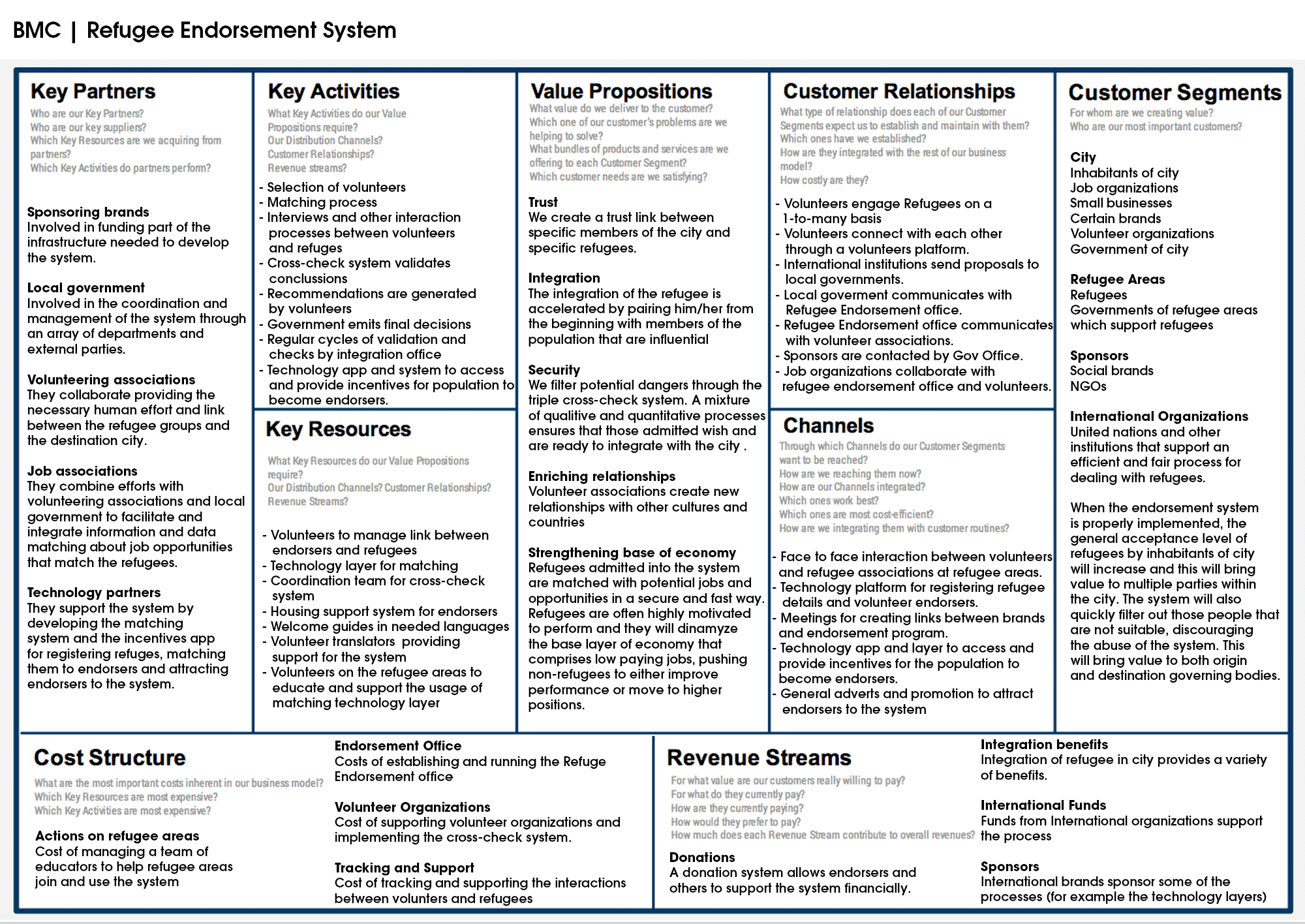
Refugees Torch Challenge
“How can we improve the acceptance level that the general population has in relation to large groups of refugees arriving to their city?”
Let’s go through an example process of using Torch to tackle a complex challenge. The acceptance, understanding, empathy and connection between the inhabitants of a city or country and large groups of refugees that escape from areas of conflict is a very complex topic that many people care about.
We will go through a very simplified and accelerated explanation on how we would apply Torch to this challenge. After reading this article, you will be able to imagine what would be possible if you applied the steps highlighted below at a much bigger scale. We will also simplify the explanations of the different steps in order to fit it all into this article. Explaining in high detail every step of the process would take a very large number of pages. We will focus on the essentials.
THE METHODOLOGY
The Torch Innovation Methodology combines aspects of leading innovation methodologies like Design Thinking and Lean. On top it adds a powerful ideation stage that is formalized with specific strategies, exercises and tools to help you diverge and generate ideas faster and wider in a multidisciplinary and multisensory way. The ideation stage is the core of Torch.

FIVE STAGES
Reaching a typical solution is easy. Reaching an innovative solution is much harder. The time that it takes to reach an innovative solution depends on two factors:
- The complexity of the challenge. Some challenges are harder than others.
- The strength of the creative muscles of those working on the challenge. The stronger your creative muscles are (your capacity to diverge), the faster you can generate innovative ideas. How do you get stronger creative muscles? The same way you get stronger body muscles. By training them. How? By using regularly a set of strategies and exercises (a training program) like that included within the torch methodology.
When we apply Torch to a challenge, we travel through five stages. Let’s summarize them.

SEED
We set an initial direction and definition for our challenge. This direction can be further refined or modified at the end of the nurturing phase.
NURTURING
To produce an innovative idea, to cook such a solution, we need to combine two types of ingredients, convergent ingredients and divergent ingredients.
Convergent ingredients are information that is directly connected to the challenge. We need to know enough about our challenge. First, we identify what we already know, and then, we research what we still don’t know. At the end of this phase we will hold a good set of convergent ingredients connected to the challenge.
IDEATION
Divergent ingredients are information that is not so directly connected to the challenge. We throw our torches far, we illuminate concepts and information that are located further away from our starting point. We generate these divergent ingredients through different strategies and exercises. Once we have a good set of convergent ingredients and divergent ingredients, we combine them. The combination of divergent ingredients with convergent knowledge may generate innovative and unusual ideas.
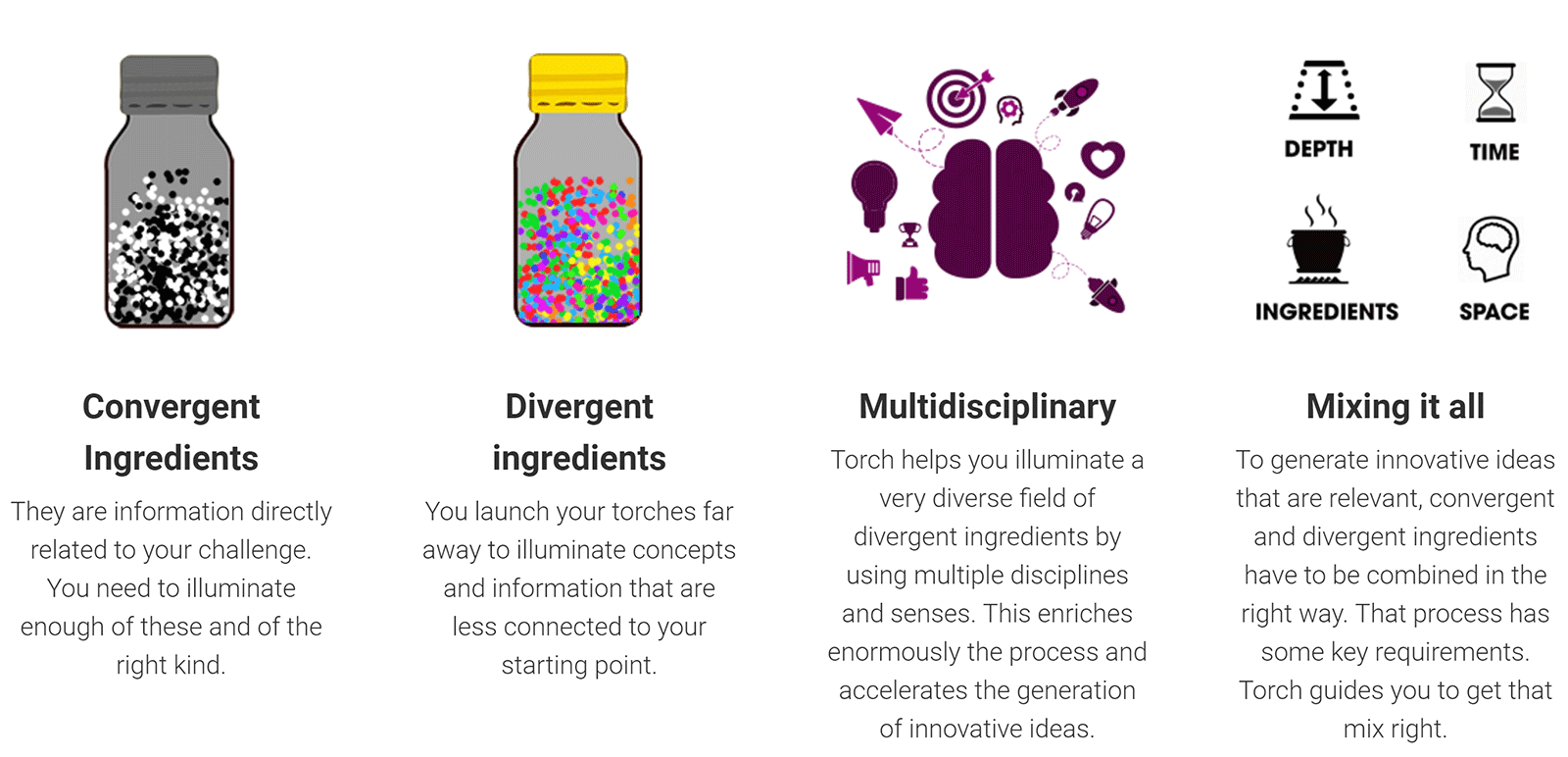
PROTOTYPING
Once we have produced a good set of ideas, it is time to express them in a tangible way that can be shared. We want to trigger valuable feedback. We do that by creating prototypes. We share these prototypes and get feedback from others. This feedback allows us to refine our prototype and iterate the process as needed.
MODEL
Once we settle in a prototype that we like, we use a variety of tools (like the business model canvas and others) to study in more detail how to bring this solution/idea to the market and how to connect it with all the other factors and parties involved.
THE TORCH CYCLES
Throughout these five stages we will go through two diverge-converge cycles (expand-contract). You can visualize them with the graphic below.
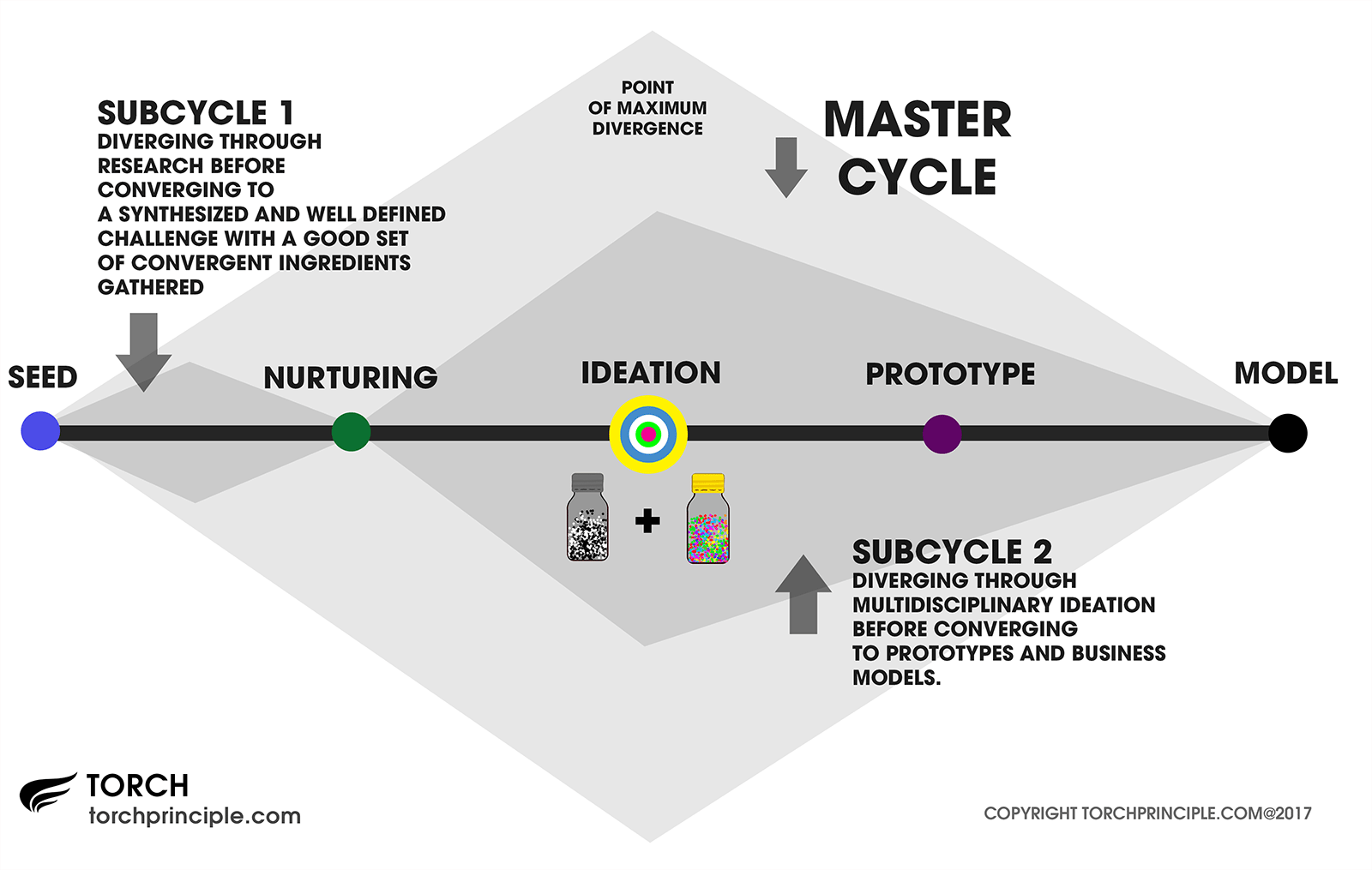
IN DETAIL
And now let’s go in more detail (although still in a very simplified way) through each of the five stages.

SEED
Let’s create a first definition of our direction, our challenge. This initial definition may be further refined or modified at the end of the nurturing phase. For now, we need some starting point.
We pick the following seed: “How can we improve the level of acceptance that the general population has in connection with large groups of refugees arriving to their city?”.
We have two choices. We can link the challenge to a specific city of a specific country, or leave it open and general. There is no right or wrong choice. Both choices will produce different kinds of results and will affect in different ways various parameters of the process. For this example we are going to leave it general.
This is a complex challenge. And that’s what we want. We want to tackle complex challenges whose typical solutions are not satisfactory enough. What would be a typical solution for this challenge? A typical solution would be: “To make people more sensitive to the issue, politicians will address the population through media and other channels emphasizing the advantages that refugees and immigrants bring to the city as well as the humanitarian aspect of things, the need to support those in need”. This is a typical solution. We know that such a solution is not enough, it is not effective enough. We need something else.
We need a solution that is more different, unusual, divergent and innovative. When we employ only analytical strategies to tackle the challenge, we tend to converge to what is typical (see above). That’s why we are going to employ strategies and exercises that will help us diverge and jump to what is more unexpected and innovative.
Of course, once we reach something unexpected and innovative, we have to make sure that it’s practical, feasible, useful and that we can implement it. That’s why the last two stages of Torch deal with evaluating and transforming some of those ideas into practical solutions we can implement.
We got the seed, let’s start nurturing it!

NURTURING
Our objective is to gather a good amount of quality convergent ingredients (nurturing stage) and divergent ingredients (ideation stage).
Having a lot of knowledge directly connected to the challenge (convergent ingredients) without having enough divergent ingredients involved in the process, pushes you to converge to the typical and conventional solutions.
But the opposite, gathering many divergent ingredients without having the necessary convergent knowledge, produces ideas that are often not practical or relevant enough. You can diverge as much as you want, but if you don’t hold the necessary base convergent knowledge about your challenge, the divergent ingredients won’t produce something useful because they have no way to connect to the details of your challenge, details that you have not gathered.
Therefore, we must first produce a good set of convergent ingredients.
Some of those we hold from the start. They are our previous knowledge, our previous experience and whatever we know already about that challenge.
Some challenges are familiar to us and we already know a lot about them. So we won’t have to nurture that seed so much at the beginning. But other challenges are not so familiar to us, and then we need more time to research and gather those convergent ingredients that are absolutely essential.
This process of nurturing is in itself a diverge-converge process (expand-contract). First we identify what we need to gather, and then we expand our knowledge by researching, interviewing people, visiting locations etc to gather all that knowledge. Finally we synthesize, summarize and gather the key insights from all that information and those become the final convergent ingredients.
In this specific case, some of the convergent ingredients that we need to gather are:
- We will get to know in detail the communities involved in the challenge, from the refugees to the different actors and parties that deal with them.
- We also want to know what political parties are involved in this city/country and what’s their attitude in relation to the issue?
- What are the current mechanisms being employed to deal with the refugees? Where are they hosted? How can they access the job market? How do they communicate with their relatives back home? Etc.
- What are the attitudes of different segments of the population in connection with the influx of refugees?
- Let’s go in detail about another one: What’s the impact of refugees on the wages of non-refugees? We research and gather these convergent ingredients from an article we find at “The Economist” Magazine which references other studies. The article states that those are most vulnerable in terms of receiving the impact of the new arrivals are existing migrants as well as unskilled workers. They are the closest and most similar substitutes for the new ones arriving. However, the study tells us that the impact is minimal. The study refers us to a paper by Stephen Nickell of Oxford University and Jumana Saleheen of the Bank of England. This study found that when a 10% rise happened in the share of migrants working in low-paying jobs (like cleaning for example), this event lowered wages for such jobs by only 2%. And in fact, this slight lowering of the wages can have positive side effects. Giovanni Peri and Mette Foged have studied the influx of refugees in Denmark between the years of 1991 and 2008. They found that the new refugees did displace the natives that had low-education out of those low-paying jobs. However, rather than suffering because of it, these displaced natives switched instead to other jobs that required less manual labour and had sometimes higher salaries.
- What are the typical reasons to reject refugees? We research and find out that some of the typical reasons are: Security risks, Scarcity arguments (regarding the resources the refugees will consume), No benefit arguments (they are not benefitial), No responsibility arguments (their problems are not our fault).
- We would keep gathering more ingredients like the previous ones. We are gathering convergent ingredients, information that provides detail that is directly connected with the challenge.
This process should continue until we estimate that we hold enough of these ingredients. What we need is enough knowledge about the challenge so that the combination of that knowledge with a good set of divergent ingredients (which we will generate in the next stage), can have the potential to produce something innovative and different.

IDEATION
We have illuminated ingredients (information) that are located close to the challenge. If we were to combine with each other only those ingredients, it is obvious that the result would also be located quite close to the beginning (given that those ingredients are all located close to the starting point). This is what typically happens in many professional meetings when those meetings are structured mainly around analytical strategies and convergent ingredients (convergent knowledge). They either move very slowly (as if we were walking step by step with our torch), or they converge onto solutions that are typical and predictable, solutions located close to the starting point.
That’s why we need to combine those convergent ingredients with others that are located conceptually much further from the starting point. We will illuminate those divergent ingredients with a combination of strategies and exercises. And those divergent ingredients, when combined with the convergent ones in the right way (the DITS process of Torch), will trigger the generation of innovative and original ideas and solutions.
This is the beginning of our second diverge-converge cycle (expand-contract). We will diverge to generate our divergent ingredients (which will be combined with our convergent knowledge), and then we will converge through the prototyping and model phases to reach well defined and specified solutions.
Now, generating divergent ingredients is not easy. Why not? Because the analytical centers of the mind try to make our life efficient by pushing us to converge to what is typical and already known. That strategy spends less valuable resources and is often faster. That’s why when you think of a challenge, you tend to come up with the typical solutions (various reasons related to our biology and the way neurons work are highlighted in The Torch Principle book.)
When you need to innovate, when you want to find solutions that are different to the typical ones (when the typical ones are not good enough), you need ways to bypass the default behaviours of your mind and avoid falling on the cliffs of closure too quickly in order to access more innovative possibilities.
Torch gives you a series of strategies and exercises that help you to:
- Bypass the analytical centers of the mind that constantly push you to converge to what is typical.
- Throw your torches far, illuminate information that is located further from the starting point.
- Combine your divergent and convergent ingredients to generate innovative ideas.
To help you with that process Torch provides:
- Unique tools to exercise your creative muscles. When you want to train your body muscles, you may use machines at the gym not because you need them, but because they accelerate the process of strenghtening your muscles. The same happens with your creative muscles and your capacity to diverge. Ideally, it’s best not to rely too much on external tools. But these tools are useful during the process of strengthening our creative muscles. As long as your creative muscles are less strong than your analytical ones, you will benefit from these kinds of tools.
- Strategies and exercises that are multidisciplinary and multisensory. When you train for a marathon, you don’t train just your calf muscles. You train your whole body because of the sinergies that exist between the different muscle groups. Training your entire body improves your global performance and the local performance of each muscle group as well. The same happens when you train your creative muscles. Torch gives you strategies and exercises that are multidisciplinary and multisensory so that you can diverge using all your potential. This improves your global performance as well as the local performance of each of the skills you will be using. Torch gives you step by step instructions to apply these strategies through specific exercises as well as a workbook you can use to document the process.
Let’s focus in this compressed article on a few of the Torch strategies and exercises. Have in mind that in an extended process you will perform many more exercises and you will generate dozens and dozens of ideas, not just a few like in this accelerated example.
We provide some examples below. The further the divergent ingredients (which we generate when we throw our torches far through different multidisciplinary and multisensory exercises and strategies) are from the starting point, the harder is to connect them to the challenge in a meaningful and useful way (but the larger the potential to generate something really unique, different, original and innovative). The time it takes to connect them depends both on how divergent the ingredients are (how far they are located conceptually from the challenge) and on the strength of the creative muscles of the participant.
1. Guided randomness + Anonymous Textures + Analog/Gesture Drawing + Visualization
We are going to combine a few techniques in parallel here.
- We will use the powerful SK-Engine tool of Torch which generates hundreds of thousands of random concepts (which we can guide, edit and structure in different ways). We contemplate a number of them, creating connections between a set of divergent ingredients and our challenge, either immediately or after some time has passed. The verbal concepts trigger visualizations. New insights are produced from the combination of those visualizations with the visualization of part or the whole of the challenge.
- We are also going to create a mixture of an Analog Drawing and a Gesture drawing, a visual representation of part of our challenge with which we will work visually.
- And we will also do an exercise of anonymous textures.
Whenever you perform an ideation exercise it is essential to visualize your challenge or part of it. In this case we are going to visualize part of the challenge. A part linked to a specific set of convergent ingredients we gathered. The ones related to the studies published by “The Economist” that state that the impact of refugees on the wages of menial jobs (such as cleaning), was very little and that in fact they even had a positive benefit (explained above).
As we visualize that context, we first perform a mixture of an analog drawing and a gesture drawing (which you can find in one of the graphics below). In this drawing, we represent the job market as a sort of a pyramid, with a large base composed of low-paying jobs and the top of the pyramid made of the very high paying jobs that employ less people. The refugees are represented with arrows coming from below, trying to access those jobs at the base. The general population is represented with circles that surround the pyramid. They are critical of the refugees that are trying to access the base of the pyramid. (for reasons that we know because we have gathered convergent ingredients that provided those details).
As we interact visually with this pyramid we begin to visualize the shape of a cake. It is a rich cake, composed of many layers, all with different qualities. Now, what is key here is that visually we understand that for the cake to stay firm and attractive, its base must be solid and stable. Otherwise it will crumble. The base of the cake is absolutely key. Then we realize that our convergent knowledge (the study of “The economist”) states that refugees can even bring benefits to this layer, and we know that refugees have often a bigger motivation to work hard at these kinds of jobs than the natives of the city. How can we take advantage of this to bring the refugees closer to the general population?
In parallel to this exercise, we perform an anonymous textures exercise. One of the textures with which we work (you can find it in one of the graphics below) makes us visualize a vascularization system that connects and regulates the blood flow. As we incubate this concept together with our convergent knowledge and the analog drawing, we begin to understand that if the base of this structure is so important, a possibility could be to create a system that irrigates, empowers, brings more “blood flow” to this base beyond what is happening today. And how will we do that?
We activate the SK-Engine and throw torches to far away concepts. A few of them, when combined with each other and with the rest of our knowledge and divergent ingredients, generate insights that complement the ones of the drawing and the texture. The concepts “unshaded” and “blaze” make us visualize that a way to help the population accept in better ways the arrival of refugees to these low-paying jobs, is by highlighting and transforming the job of these refugees in bright, attractive lights so that everybody can visualize their key contribution to the strong base of the economy. This key contribution should be unshaded and bright, and also empowered in some way.
To understand how to do that, we return to the drawing. By watching our drawing in combination with the previous insights, we get another insight: something or somebody needs to power those lights. We need to create a bidirectional feedback system between the population and the base layer. That is, the people of the city will be able to rate the performance of workers at this base layer of the economy. This will be done through a mobile app and a system managed and coordinated by the government. The stats generated by the app will be public. This gives the refugee the possibility of becoming a bright light that represents solidity and success at the base layer of the economy.
What is key is that this light is being powered by members of the population themselves through their use of the tech system managed by the goverment. In a way, the members of the population will gradually become fans of the best performing refugees. And all the refugees will have even more incentive and motivation to excel. Non-refugees will either move to other jobs that require less manual labor and are better paid (as stated by the studies highlighted by “The economist”), or will now have to work harder and push themselves to excel even more, which benefits all the same that base layer and the whole economy.
In addition, the workers at this base layer could rate the people they work for (hence a bidirectional feedback system). This could increase trust and empathy between both sides. However, there are a number of challenges associated with this feature and those challenges can be explored later in detail at the prototyping and model stages.
What is crucial in this example is to understand how these insights can only be born by having both great convergent ingredients and great divergent ingredients. Both are key. Without knowing about these studies highlighted by “The Economist”, without having those convergent ingredients, we would have never reached these insights, no matter how much we diverge. And viceversa, by only having those convergent ingredients without throwing our torches far to illuminate divergent ones as well, we would not have jumped so quickly to these original insights.
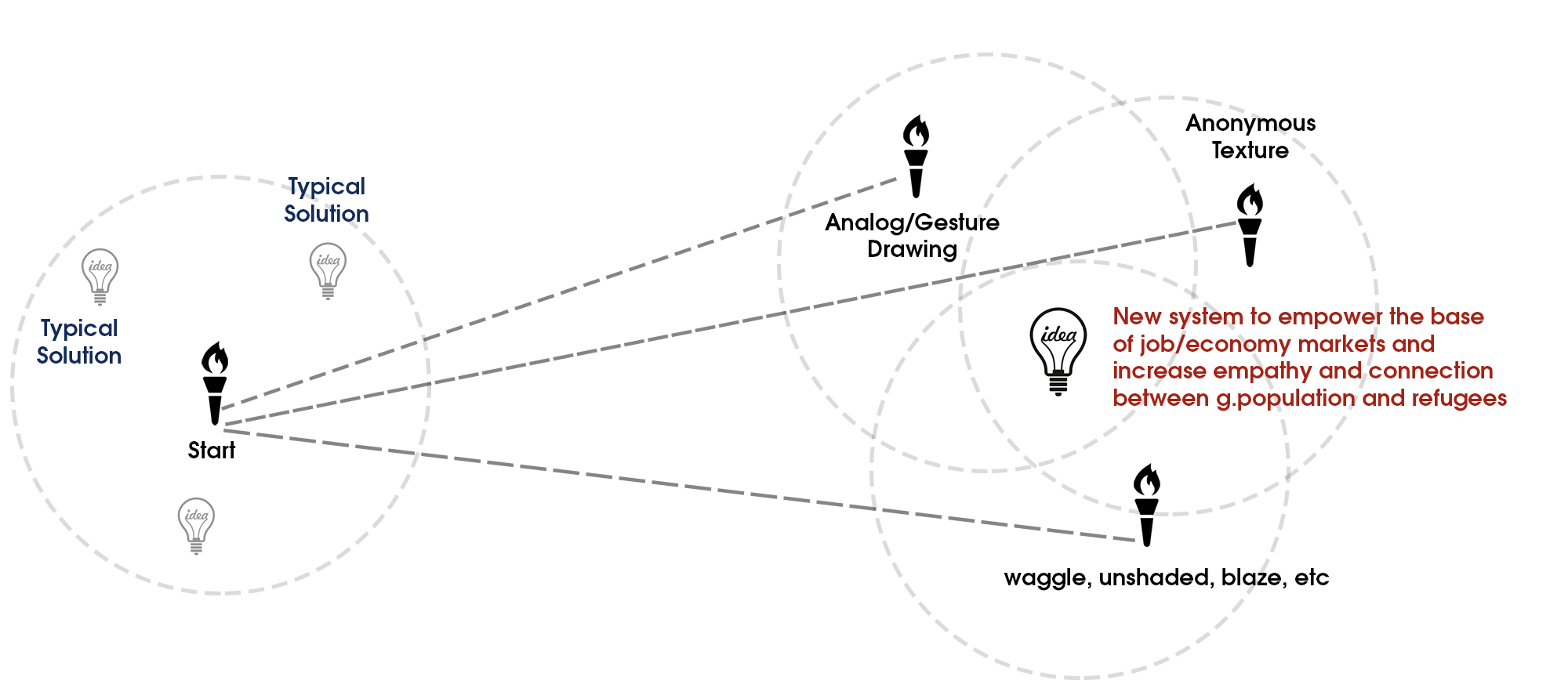


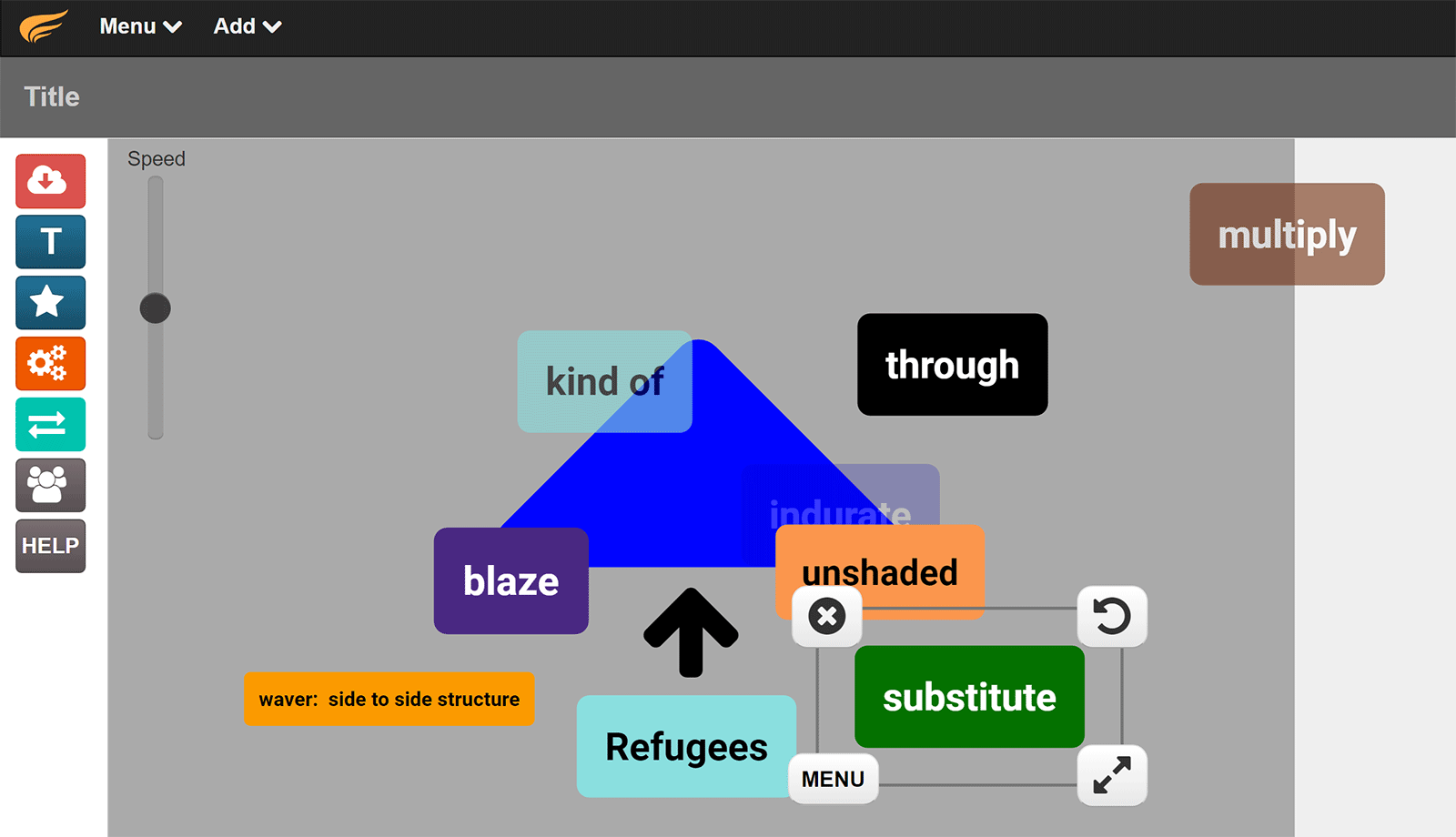
2. Guided randomness + Visualization
We use the powerful SK-Engine tool of Torch. In this case, we throw two random torches to two concepts generated by the tool: Okeh and Uvular. Okeh is a concept that expresses a kind of endorsement. Uvula is a part of our bodies which may be involved in the process of producing speech, giving voice. These concepts make us visualize endorsements that provide the necessary bridge (trust) between the refugees and the population, and we visualize that these endorsements come from the population itself. Every potential refugee will have a way to share his/her background with the population of the new city/country. Every city/country has a considerable number of people that are willing to support the refugees. These will voluntarily access the profiles of the refugees and engage with them through interviews and other ways. Therefore, a specific inhabitant of the new city will endorse a specific refugee. This endorsement system will support not just the integration of the refugee but it will also serve to filter any potential dangers.
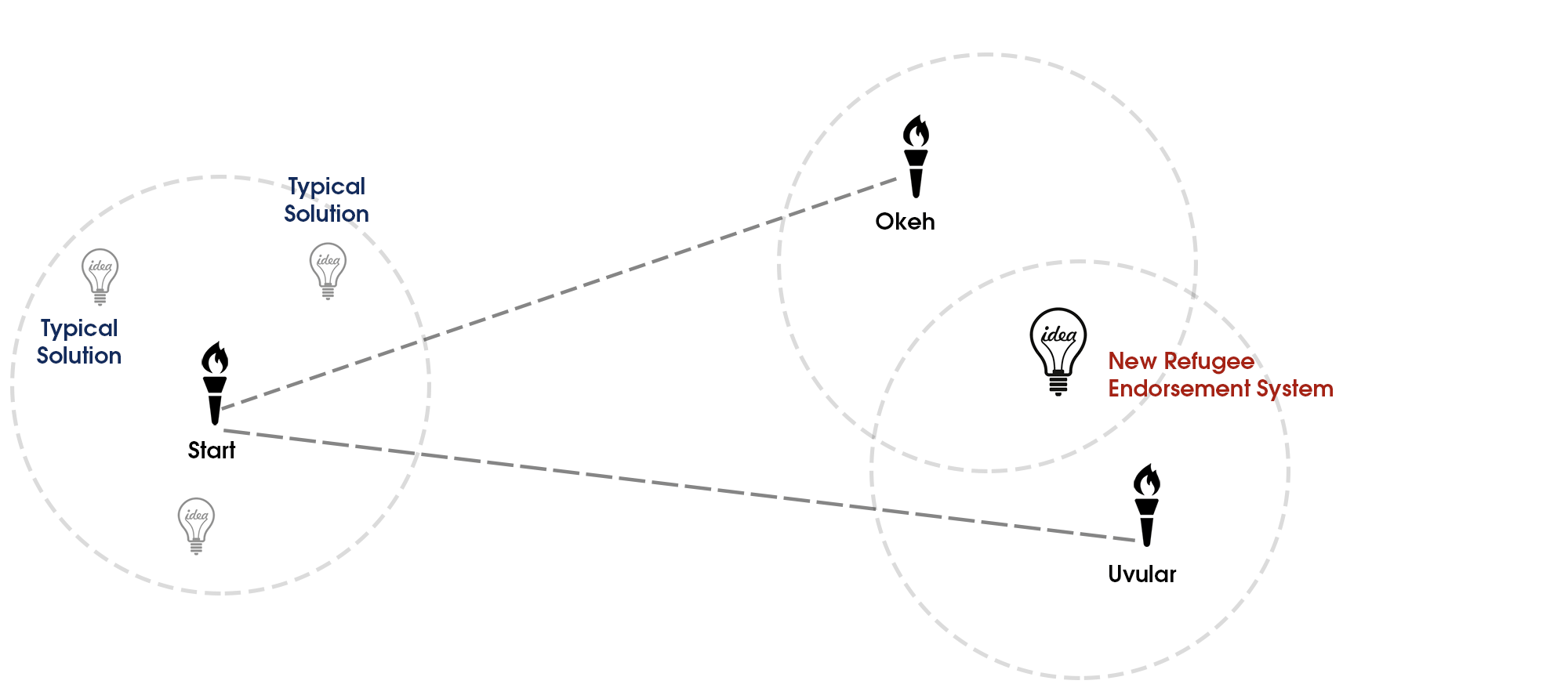
3. Soundstorming (anonymous sounds) + Embodiment + Visualization
In this exercise we use the torch soundstorming tool to throw new torches by interacting with acoustic stumuli. The soundstorming tool provides dozens of concrete and anonymous sounds (anonymous sounds are those that cannot be labeled and recognized by our analytical centers, allowing us to diverge and interpret them in infinite ways).
An anonymous sound makes us visualize a spring that bounces up and down. When we incubate that visualization together with the convergent ingredients we hold, we visualize the refugee on top of a spring that allows him/her to jump obstacles. These are the obstacles the refugee finds when entering a new country. Now we wonder, what is this spring?
We combine this exercise with another one, an embodiment performance in which we visualize and act the previous context. We incubate the mixture of the performance and our convergent knowledge. An insight emerges. We visualize this spring in the form of an institution. One that is like a spring, very flexible and very adaptable to the context of the refugees. How can it be so adaptable? We visualize that the spring is made of the refugees themselves. That’s why it is so adaptable to them. So we visualize an institution whose employees are former refugees that therefore know very closely the reality of being a refugee. Furthermore, the refugees that direct this institution have already been well integrated into their new society. They are well accepted and provide a perfect bridge between the new ones and the rest of the population.
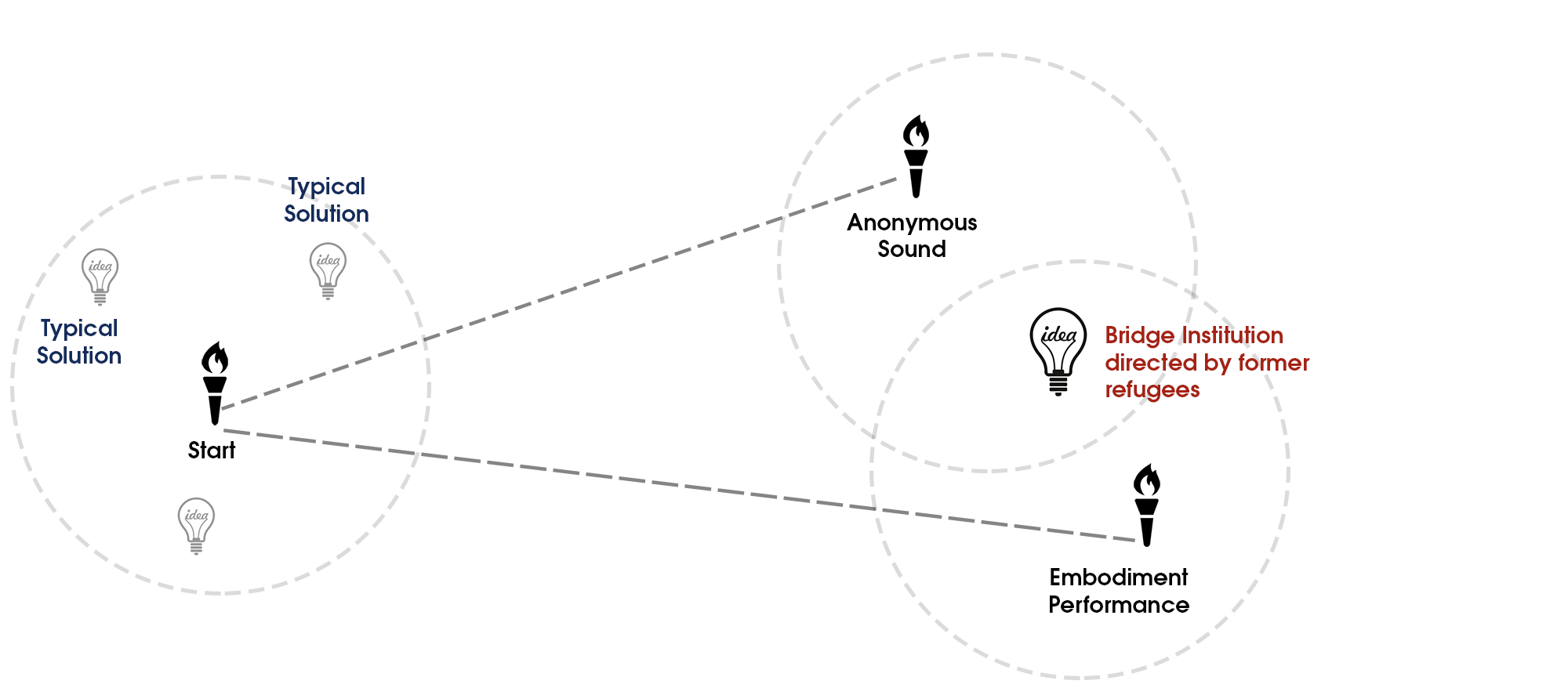
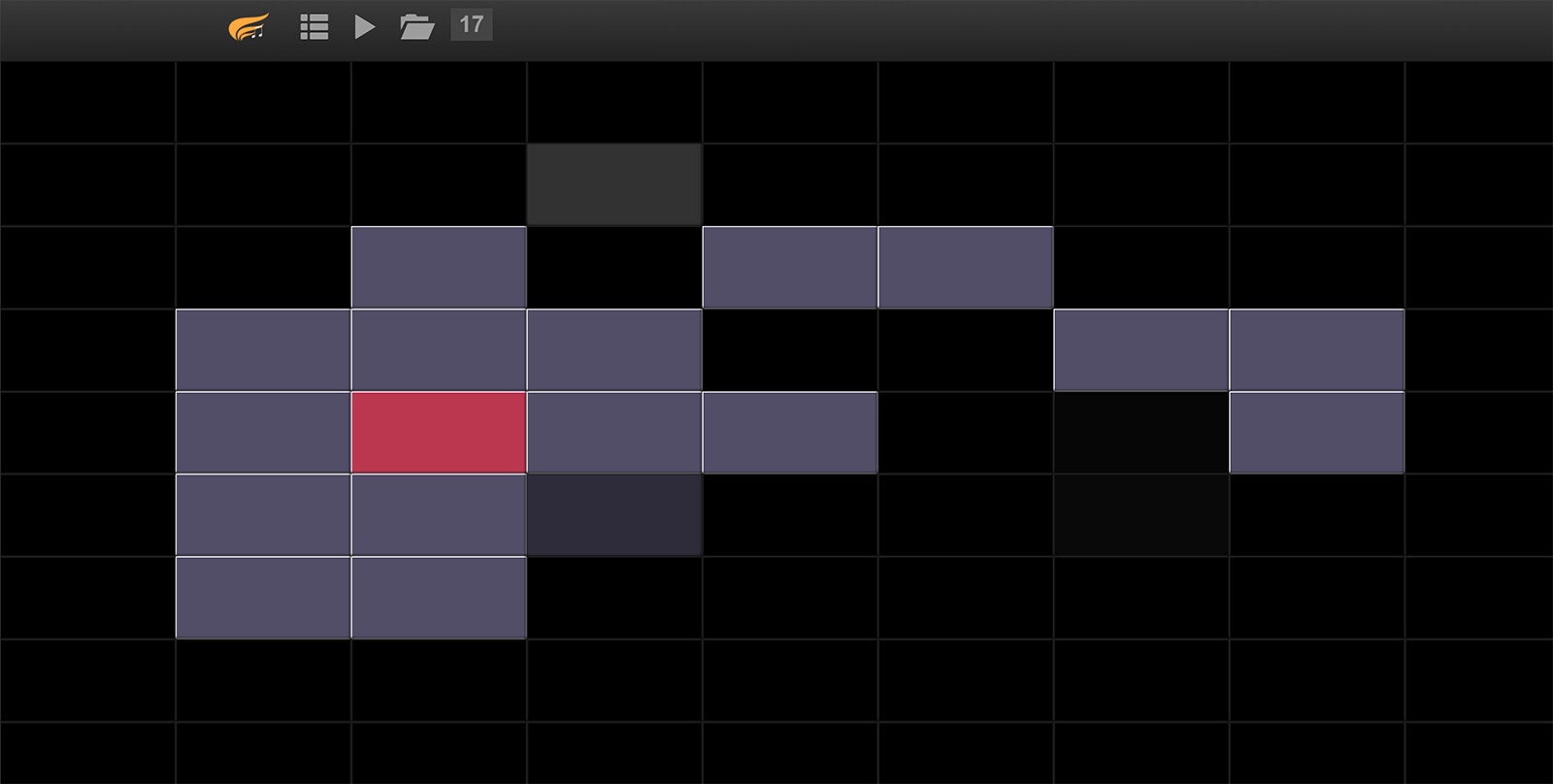
4. Gesture Drawing + Visualization
We throw a torch far away to illuminate new divergent ingredients through the creation of a quick gesture drawing that emerges from visualizing our challenge and expressing it on paper in a very spontaneous way. We visualize our challenge and spontaneously begin to draw. We intuitively represent the inhabitants of the city with squares, and the influx of refugees with lines that converge towards the city.
Spontaneously, as we draw the lines (born from our visualization), we make them curl inwards to make dense balls of ink that advance together. We are expressing visually how these communities tend to interact mainly with each other, preventing a deeper integration with the new city. As we draw, we see the challenge with a lot of clarity. And we interact and absorb the challenge visually. We wonder: how can we break into these dense balls of lines, how can we help them spread around, become less tight, blend with the rest of the population? How can our squares, that represent the inhabitants of the cities, break into those balls so that integration becomes easier. We continue working on the challenge visually. We don’t use words. We contemplate, reflect, understand and try to solve the challenge visually.
We decide that a way to solve the situation is to take some of the squares and bring them to the root, to the start of the process. We can try to integrate some of the squares within these communities before they start their way to the new city. This way, by the time they arrive to the city, these balls of lines will have squares within, and those squares will encourage and help the balls to disperse and spread around. The divergent drawing (the torch) has illuminated a new insight. Now we can take some time to analyze what it all means.
What does it mean bringing some squares to the roots of those lines? It could mean, for example, that some volunteers from the city will first go to those refugee communities and spend some time living and interacting with them, establishing early bridges with those communities. That will facilitate mutual educational processes, beneficial for both sides. This is all helping to create bridges between both cultures. By the time the refugees move to the new city, they will be accompanied by volunteers that have developed connections and generated mutual empathy. This will facilitate their integration within their new environment. Further details of the implementation of this insight would be developed during the prototyping and model phases.
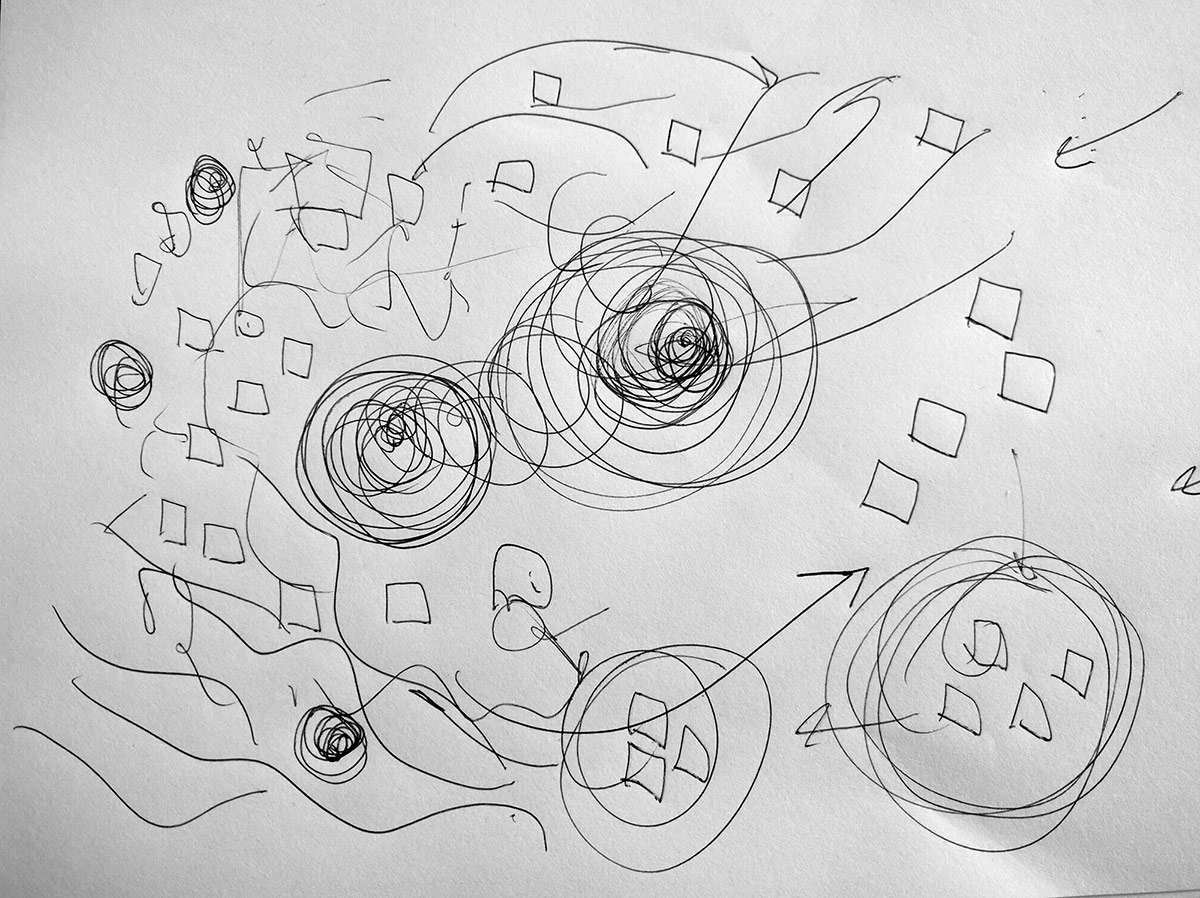


PROTOTYPING
In this accelerated, super compact example, we have generated a few ideas. In an real extended process, we would have generated dozens or hundreds, as many as possible. We would then select the most promising ones for the next stages. To select the most promising ones there are many possible strategies. A simple one is to share them with the rest of the participants and vote for the “best” ones. In this accelerated example we select a couple of the ideas generated in the ideation phase, the simplest ones (numbers 2 and 3 stated above). We choose the simple ones to make this article shorter.
Prototyping is all about transforming our ideas into something tangible that we can share with others. A prototype should use as little resources as possible and yet be as close to a real tangible solution as possible. We share it around, gather feedback and in response to that feedback, polish our prototype and iterate the process as needed.
We can create prototypes in many different ways:
- Paper prototypes
- Experiential prototypes
- Simulations
- Storyboards
- Any other means
In the case of the idea number 2, we decide to create an experiential prototype. What is key in this idea is that the endorsements come from parts of the population that are not refugees, therefore facilitating the integration of the refugees and the acceptance of the rest of the population. We simulate the context by acting it, taking on the different roles involved in the challenge. We act out the solution and we share this performance with others.
As we prototype the solution and receive feedback, it becomes clear that we cannot trust this process to a one to one interaction. Therefore, a peer-to-peer cross-check system will be created in which every endorsement is triple checked by other members of the volunteering organization. We also identify an issue with language. We will need an extra lawyer of volunteers that provide translation services when a common language doesn’t exist. We have now refined our prototype and we can keep doing this until we are fully satisfied with it.
In the case of the idea number 3, our prototype is made of a combination of storyboards and another experiential prototype. As we enact our solution, we realize that the refugees that direct this institution should be deeply connected to the rest of the population. We need a strong link between the incoming refugees and the former ones but also between the former ones and the rest of the population of the city. For that, it would be beneficial if they had strong relationships with a diversity of people in the city. We refine the idea by making sure that a committee from the city’s government oversees that the refugees involved establish or already have relationships with a wide diversity of areas and parts of the city. Also, we will create rewards for the refugees involved in the institution. These rewards will be set in proportion to the refugee’s level of integration. The institution will also create activity programs in the city which will be directed by the former refugees and the incoming ones. This way, the integration of new refugees with their new city will become easier. We have refined our prototype and again we can keep doing this until we are fully satisfied.
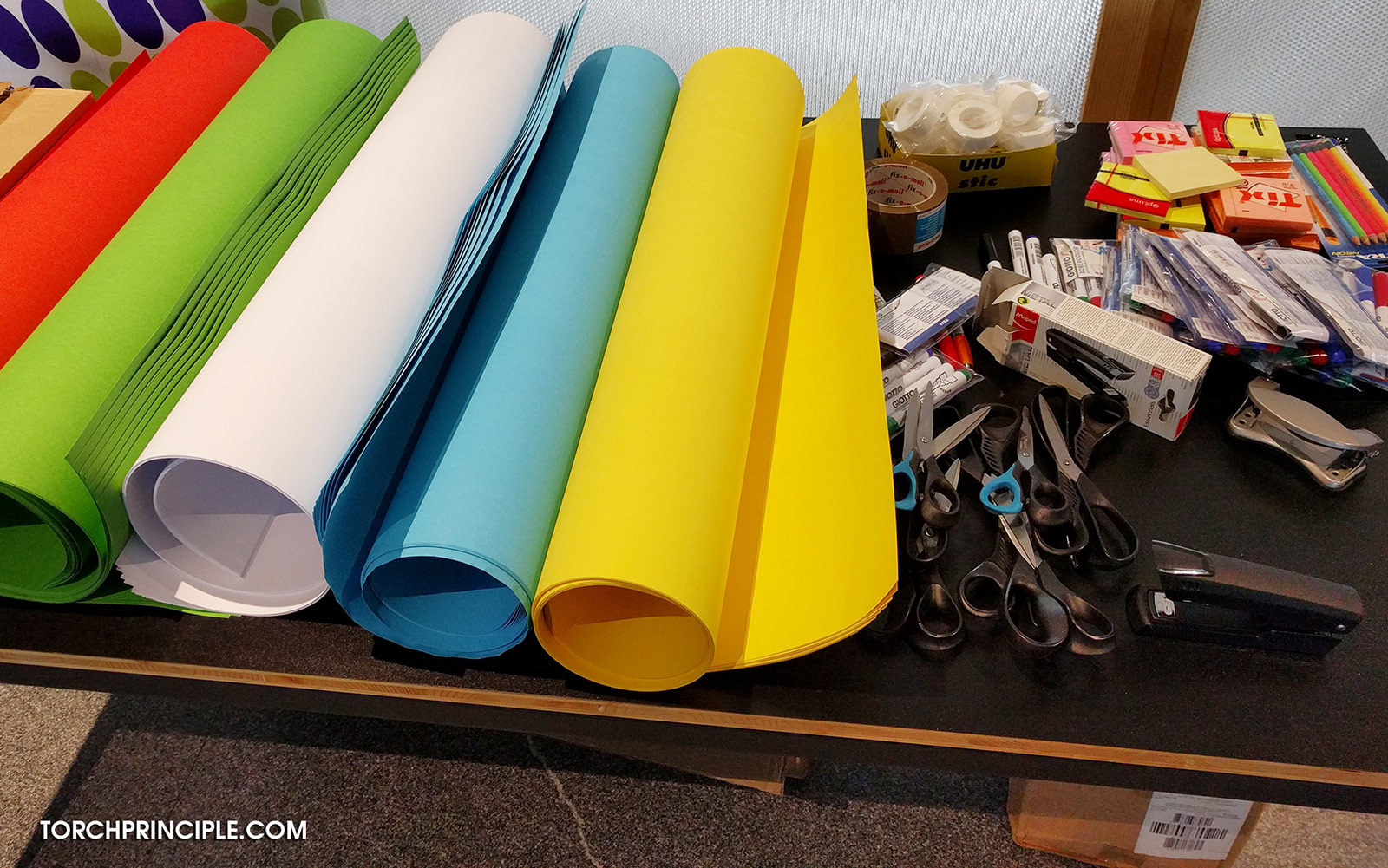

MODEL
The model stage is all about going into deep, convergent detail about the implementation details of our solution. We do it in a “lean” way, so that we can keep iterating the process quickly as needed. In this stage we use a variety of tools and to give a quick example, one of them is the Business Model Canvas.
A BMC allows you to study the viability and details of implementing a solution by completing a one page canvas that is divided in different sections. It is often used in connection with businesses as a tool to create a summarized business plan quickly but it can be applied in any context. A typical BMC is divided in areas such as: Key partners, Key activities, Value proposition, Customer relationships, Customer segments, Key resources, Channels, Cost Structure, Revenue Streams.
By filling in this canvas, we will provide and study the specific details related to the implementation of the solution. In a single page we will access and explain all the key details of our implementation. The canvas can trigger feedback or insights that can take us back to do more nurturing, ideation or prototyping, or even to redefine our seed. The process continues until we obtain a result whose implementation details are satisfactory.
In this article, we have covered a very simplified example of a Torch process. You can now visualize a similar process but employing many more strategies, exercises and tools provided by Torch, which will generate dozens of ideas, some of which will converge to innovative and practical solutions and implementations.
